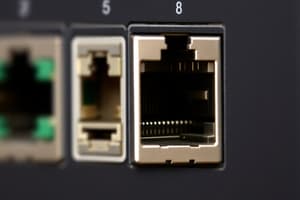Podcast
Questions and Answers
What 48-bit-long physical address is used to identify a network device?
What 48-bit-long physical address is used to identify a network device?
MAC address
An IPv4 address contains how many bits?
An IPv4 address contains how many bits?
32
What do you call taking an IP address range and breaking it into smaller pieces?
What do you call taking an IP address range and breaking it into smaller pieces?
subnetting
What is used to determine the network portion of an IP address?
What is used to determine the network portion of an IP address?
What logical truth table is used to isolate the network address from an IP address using the subnet mask?
What logical truth table is used to isolate the network address from an IP address using the subnet mask?
Traditional IP networks were divided into a Class A, Class B, and Class C networks. What do you call this type of addressing?
Traditional IP networks were divided into a Class A, Class B, and Class C networks. What do you call this type of addressing?
What is the default subnet mask for the 198.25.4.129 address?
What is the default subnet mask for the 198.25.4.129 address?
How many hosts does a Class C network support?
How many hosts does a Class C network support?
Your system is configured to receive DHCP addresses. It is assigned an address of 169.254.34.7. What type address is this?
Your system is configured to receive DHCP addresses. It is assigned an address of 169.254.34.7. What type address is this?
When your system running Windows 7 is configured to receive a DHCP address, what happens when your system cannot contact a DHCP server?
When your system running Windows 7 is configured to receive a DHCP address, what happens when your system cannot contact a DHCP server?
Which of the following is not a private IP address range?
Which of the following is not a private IP address range?
What is the CIDR notation used for the 255.255.255.0 subnet mask?
What is the CIDR notation used for the 255.255.255.0 subnet mask?
What is the binary equivalent of 180?
What is the binary equivalent of 180?
What is the binary equivalent of 255.255.0.0?
What is the binary equivalent of 255.255.0.0?
An IPv6 address contains how many bits?
An IPv6 address contains how many bits?
What is the hexadecimal equivalent of 255?
What is the hexadecimal equivalent of 255?
Study Notes
Networking Addressing Overview
- MAC Address: A unique 48-bit physical address assigned by manufacturers to identify network devices; usually fixed and unchangeable.
IPv4 Addressing
- IPv4: Comprises 32 bits divided into four 8-bit groups (octets); currently the oldest version of the IP protocol.
- Subnetting: The process of dividing an IP address range into smaller ranges, allowing for multiple networks to use parts of the same IP range.
Understanding Subnetting
- Subnet Mask: A binary number that defines the network portion of an IP address. It consists of a series of 1s followed by 0s, indicating the split between the network and host identifiers.
- Logical AND Operation: Used to isolate the network address from an IP address by comparing it with the subnet mask.
Classful IP Addressing
- Classful Addressing: Early IP addressing categorized as Class A, B, and C; defines network ID and host portions of the address. Only Classes A, B, and C are typically used.
Default Settings and Host Capacity
- Default Subnet Mask for Class C: 255.255.255.0; addresses from 192 to 223.
- Class C Host Support: Supports up to 254 hosts per network; there are 2,097,152 such networks.
Automatic Private IP Addressing (APIPA)
- APIPA Range: IP addresses assigned automatically when a DHCP server is unreachable, using the Class B block from 169.254.0.0 to 169.254.255.255.
Recognizing Private IP Ranges
- Private IP Addresses: Include ranges 10.0.0.0 to 10.255.255.255, 172.16.0.0 to 172.31.255.255, and 192.168.0.0 to 192.168.255.255. The address 128.0.0.0 to 128.255.255.255 is not a private IP range.
CIDR Notation
- CIDR Notation: Expresses subnet masks in shorthand; for example, the subnet mask 255.255.255.0 is represented as /24.
Binary and Hexadecimal Conversions
- Binary Representation of 180: 1011 0100; calculated by summing corresponding binary values.
- Binary Equivalent of 255.255.0.0: Written as 11111111.11111111.00000000.00000000.
- IPv6 Addressing: Utilizes 128 bits; expressed in hexadecimal format to accommodate a larger address space.
- Hexadecimal Equivalent of 255: Conversions yield FF; derived from binary representation 1111 1111.
Studying That Suits You
Use AI to generate personalized quizzes and flashcards to suit your learning preferences.
Description
Test your knowledge of networking addressing concepts with these flashcards from CTS1134. Learn about key terms such as MAC addresses and IPv4 addresses. Perfect for students preparing for networking exams or just looking to enhance their understanding of network devices.




